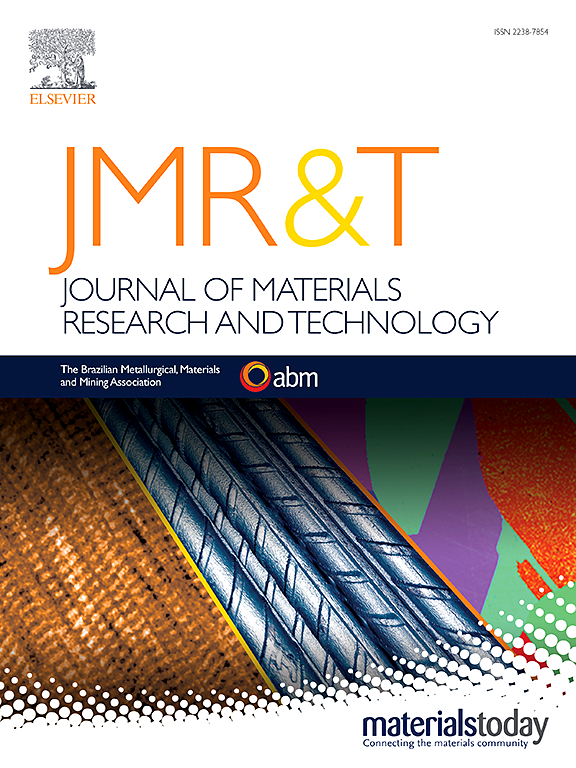Exploration of ductility for refractory high entropy alloys via interpretive machine learning
IF 6.2
2区 材料科学
Q1 MATERIALS SCIENCE, MULTIDISCIPLINARY
Journal of Materials Research and Technology-Jmr&t
Pub Date : 2025-06-12
DOI:10.1016/j.jmrt.2025.06.085
引用次数: 0
Abstract
Refractory high-entropy alloys (RHEAs) having excellent thermo-mechanical properties always suffer from room temperature brittleness, due to the inherent brittleness of refractory metal elements. RHEAs with compressive ductility ≥30 % hold particular commercial value. While ductility can be engineered through alloying composition and processing condition optimization, this remains challenging due to the virtually infinite and vast unexplored compositional space. Data-driven machine learning (ML) can significantly reduce experimental costs and time by establishing robust correlations between RHEA compositions and ductility. This study constructs an ML model for accurate ductility prediction from sparse compositional data, accelerating the design of ductile RHEAs within infinite compositional space. Two ML algorithms, decision tree (DT) and CatBoost, are trained using physical parameters, with CatBoost demonstrating superior performance in RHEA ductility classification. Integration of the shapley additive explanations (SHAP) model with sample data reveals key relationships between physical parameters and RHEA ductility, providing theoretical insights for developing high-ductility RHEAs. The analysis identifies δχ, Tm, VEC, and ΔHmix as critical factors in RHEA ductility prediction, with a quasi-linear relationship observed between ΔHmix and ductility. Through the prediction and subsequent preparation of TiZrNbTax (x=0.3, 0.5, 0.7, 1) alloys, the experimental results confirmed the reliability of the proposed model and key parameters. This approach establishes a novel methodology for exploring and developing RHEAs with excellent ductility.
利用解释性机器学习探索难熔高熵合金的延展性
由于难熔金属元素固有的脆性,具有优异热机械性能的难熔高熵合金(RHEAs)往往存在室温脆性。抗压延性≥30%的改性塑料具有特殊的商业价值。虽然延展性可以通过合金成分和加工条件优化来设计,但由于几乎无限广阔的未开发成分空间,这仍然具有挑战性。数据驱动的机器学习(ML)可以通过建立RHEA成分与延性之间的鲁棒相关性,显著降低实验成本和时间。本研究构建了基于稀疏成分数据的精确延性预测机器学习模型,加速了无限成分空间内延性rhea的设计。两种机器学习算法,决策树(DT)和CatBoost,使用物理参数进行训练,CatBoost在RHEA延展性分类中表现出优异的性能。shapley加性解释(SHAP)模型与样本数据的集成揭示了物理参数与RHEA延性之间的关键关系,为开发高延性RHEA提供了理论见解。分析发现δχ、Tm、VEC和ΔHmix是预测RHEA延性的关键因子,ΔHmix与延性呈准线性关系。通过对TiZrNbTax (x=0.3, 0.5, 0.7, 1)合金的预测和后续制备,实验结果证实了所提模型和关键参数的可靠性。该方法为探索和开发具有良好延展性的RHEAs建立了一种新的方法。
本文章由计算机程序翻译,如有差异,请以英文原文为准。
求助全文
约1分钟内获得全文
求助全文
来源期刊

Journal of Materials Research and Technology-Jmr&t
Materials Science-Metals and Alloys
CiteScore
8.80
自引率
9.40%
发文量
1877
审稿时长
35 days
期刊介绍:
The Journal of Materials Research and Technology is a publication of ABM - Brazilian Metallurgical, Materials and Mining Association - and publishes four issues per year also with a free version online (www.jmrt.com.br). The journal provides an international medium for the publication of theoretical and experimental studies related to Metallurgy, Materials and Minerals research and technology. Appropriate submissions to the Journal of Materials Research and Technology should include scientific and/or engineering factors which affect processes and products in the Metallurgy, Materials and Mining areas.
 求助内容:
求助内容: 应助结果提醒方式:
应助结果提醒方式:


